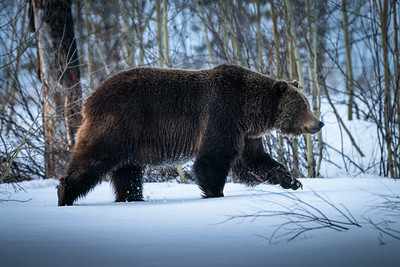Black bears and grizzly bears are two distinct species of bears found in the greater Jackson Hole area. Here are some differences between them and how to act when facing them:
Table of contents

- Black bears are smaller and more timid, while grizzly bears are larger and more protective.
- Black bears come in various colors, including black, brown, and white, while grizzly bears are typically brown.
- Different behaviors in response to human encounters: black bears tend to flee, while grizzly bears can be more aggressive.
- Safety tips for encounters: stand your ground with black bears, play dead with grizzly bears, and always carry bear spray.
Black Bear vs Grizzly: Appearance and Color
Recently when I was hiking down to Phelps Lake in Grand Teton National Park, a light brown flash caught my eye. I turned and saw it – the hump on its back, the shape of it’s body. I was a grizzly bear about 10 yards away. For those of us who live in Jackson Hole and surrounding region, we can spot the differences of Black and Grizzly bears right away. But for those who are new to the area or are just visiting, it is not so easy.
.Black Bears: Appear smaller and more streamlined in appearance. They have shorter, curved claws better suited for climbing. Despite their name, they can come in various colors, including brown, cinnamon, and even white. However, their most common shade is black.
Grizzly Bears: They are larger and more muscular, with a pronounced hump on their shoulders. Their claws are longer and straighter, adapted for digging and digging. Typically have a brown fur color, which can range from light to dark shades.

Difference in Behavior: Which Bear is more Aggressive?
Black Bears: They are generally more timid and may be more likely to flee from humans. However, they can still be dangerous if cornered or provoked.
Grizzly Bears: They are known to be more aggressive and protective, especially if they feel their cubs are threatened. Hence, an encounter with a grizzly demands a different level of caution.

Where Bears Live
Black Bears: Found in a variety of habitats, including forests, swamps, and mountainous regions.
Grizzly Bears: Often inhabit more remote and rugged wilderness areas, including forests, tundra, and alpine meadows. Grizzlies make much more use of large, non-forested meadows and valleys than do black bears. Sometimes, though, grizzlies make their way into populated areas .

What to do When Encountering a Black or Grizzly Bear
Black Bears: If you encounter a black bear, your goal is to appear non-threatening and to encourage the bear to leave. Stand your ground, speak calmly, and make yourself look larger by raising your arms. Back away slowly without turning your back on the bear.
Grizzly Bears: If you encounter a grizzly bear, it’s important not to appear as a threat. Speak in a calm voice and slowly back away without making sudden movements. Avoid direct eye contact, as staring can be seen as a challenge. If the bear approaches, play dead by lying on your stomach, covering the back of your neck with your hands, and spreading your legs to make it harder for the bear to turn you over.

Bear Attack Statistics
- Grizzly bears are 21 times more dangerous than black bears according to the World Animal Foundation.
- There have been 8 fatal bear attacks in Yellowstone National Park since 1872, and all were committed by Grizzly Bears.
- Since 1900, 61 people have been killed by a black bear in North America
- 24 people were killed by Grizzlies between 2000-2015.
- You have a higher chance of dying an avalanche, or getting struck by lightning than a Yellowstone bear attack — one in 2.7 million.
Conclusion
The distinctions between black bears and grizzly bears are not only fascinating but crucial for ensuring human safety when encountering these majestic creatures. Their differences in appearance, behavior, habitat, and reactions to humans define the protocols for dealing with them. While black bears tend to be more timid and often flee, grizzly bears’ protective nature demands a higher level of caution. When hiking in Jackson Hole or the greater Yellowstone ecosystem, remembering the key safety tips—standing your ground with black bears and playing dead with grizzlies—can significantly contribute to peaceful coexistence. While bear attacks are rare and fatalities even rarer, understanding these differences and respecting their habitats is essential to preserving the harmony between humans and these remarkable animals.
- Problem Grizzly Put Down in Big Sky - August 11, 2023
- Yellowstone Revealed Explores Indigenous history - August 9, 2023
- Wyoming Baseball Team to the American Legion World Series - August 9, 2023
